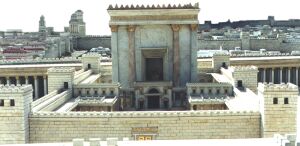The Ten Plagues By Rabbi B. Horovitz
The Ten Plagues
By Rabbi B Horovitz
The concept of the Ten Plagues which brought Egypt to destruction and Pharaoh to recognize the power of Hashem has a deep structure if one goes more deeply into the verses. Today, there have been great numbers of excavations in Egypt and amongst the excavations, they found Egyptian descriptions of the Ten Plagues, especially the Ipuwer Papyrus, discovered quite some time ago. Other excavations demonstrate how Egypt collapsed because of the Ten Plagues.
Other Structures of Ten Within Judaism
Our Sages (in Pirkei Avos Ch5, Mishna 1), understood from the Chumash, that the world was created with ten sayings. When analyzing the first chapter of Bereishis, it says 9 times ‘Vayomer’, namely, he said, which means a ‘maamar’, a saying, of G-d. The Mishna says there were ten sayings, because Bereishis was also a saying. We also know the significance of the Aseres HaDibros, or in English, the ten declarations at Mount Sinai.
There is a difference between a ‘maamar’ and a ‘dibur’. A ‘maamar’ is an expression of thought. ‘Dibur’, the singular form of Dibros, is a precise declaration in words. While a mamar expresses the intention G-d has in mind in creating the world onten levels, so also in the Aseres HaDibros, the Ten Words or Declarations, G-d wanted whoever would listen (ideally the whole of mankind, but in practice only Am Yisroel, consented) to go and apply the real intention of the world, in life.
The Transition from the Stage of Creation to the Stage of Fulfilling G-d’s Words
In order to lead us from the level of the world and man at creation to the level where man fulfils the word of G-d, we have theTen Plagues that demonstrate the hands of G-d, in a figurative way. Thus when the Egyptians are plagued by Kinnim (lice), the Hartumim (the Egyptian priests) acknowledge that ‘this is the finger of G-d’ (Shmos 8,15). The expression, “finger of G-d” was used, since man was created “in the image of G-d” (Bereishis 1, 27), which means the physical body of man represents the spiritual power of G-d.
The word hand symbolizes power, because man exercises power through his hands. Similarly G-d created the world with the power of his thoughts, in ten sayings, each level representing one of ten fingers. By means the People of Israel G-d brought to mankind the idea that man is supposed to be a partner who brings the maamar (thought) into a dibbur (declaration).
The Ten Plagues Serve as a Revelation
The choice of the people of Israel was to reach the level where they would be really motivated to keep the Torah, so G-d brought revelation of his power over nature, over man, and revealed his choice of Am Yisroel through the Plagues. G-d smote the Egyptians with his two hands, as it were. Of course this is all metaphorical. G-d took Am Yisrael out of Egypt with a strong hand and an outstretched arm (Deuteronomy 11,2). Each plague represents one of the fingers of G-d, demanding that we should return to Him, through Teshuva. “Viyedatem ki ani Hashem’” or similar phrases are mentionedten times in the description of the Ten Plagues in the portions of Vaera and Bo (Shemos 7-12). As mentioned, each plague was like one of G-d’s fingers (Shemos 8, 15). Fingers represent the recognition that everything that is happening in the world is directed by G-d.
The Number Ten, a Symbol of Unity and Satisfaction
The concept of the 10 is the symbol of unity found amongst diversity. The word eser (ten) is connected to the word Osher, wealth. Wealth means that a person has everything that he wants. There are two ways that a person can have everything that he wants. One way is, whatever he has, he is happy with. He has what he wants and he wants what he has. Then he reaches real wealth. The Sages say, ‘Who is wealthy? A person who is happy with his portion’. (Ben Zoma, Avos 4, 1). A person who is unhappy with his portion, even though he may be a millionaire or a billionaire, if he is unhappy with his portion, then he is not really wealthy. Wealth is measured not by what a person possesses but by what he misses. If a person has a billion dollars, but is short of another billion, he feels poor to the extent of 1 billion dollars. The person who only has 100 dollars but is happy with those 100 dollars is a truly rich man.
There is also a connection in Hebrew between אשר Osher, namely, happiness, (which is spelled the letters Aleph, Shin, Yud) and עשר Osher, namely, wealth (which is spelled by the letters Ayin, Shin, Yud).
When Esav was offered a lot of presents, he responded, ‘I’ve got a lot’, implying, ‘however, there is room for more’. In contrast Yaakov Avinu, when offered a lot of presents by Esav, stated, ‘I’ve got everything’ (Bereishis 33, 9-15). If you’ve got everything, then you are completely happy.
The Making of Unity
Creation contains many different phenomenon, such as the various forces and different types of creatures. All of them are united by One G-d, who sustains and controls them all. This is the concept of the world being created in tensayings.
The Torah too, unifies the diverse. It contains many diverse mitzvos, all of which are united by the unity of G-d. This brings unity to our lives. This brings unity and peace to society.
The Ten Commandments, the Totality of Torah
The Ten Commandments, the Ten Declarations, contain the totality of Torah. The Babylonian Sage, Rav Saadiya Gaon under the headings of the Ten Commandments, wrote one of the first books, Sefer Hamitzvos that list in detail our entire set of mitzvos. We also know that the Aseres Hadibros contain, in Hebrew, 620 letters. That is the numerical value ofכתר (crown), the crown of Torah. This represents the 613 mitzvos of the Torah and 7 ordinances (Takanos) of the Sages, based on the Torah. Through the 620, all mankind should recognize the power of G-d.
Part 2
Mitzrayim, the Wayward Son
The treatment of Mitzrayim can be compared to the details of how the Torah relates to a wayward and rebellious son, (Ben Sorer UMoreh). A son who does not listen to the voice of his father and mother is chastised. The parsha of a rebellious son is given in order to teach us a lesson about education. Rav Hirsch based his essays on the education of teenagers from principles that are present in the concept of the Ben Sorer UMoreh. The rule is that when the Court, the Sanhedrin has to chastise the son, who is rebelling against his parents, that son is given three warnings, three times, in front of three judges (dayanim). Then they give him lashes (malkus), until he listens (Sanhedrin 88). Similarly, we can say Pharaoh and the Egyptians refused to listen to G-d; they did not recognize that the people of Israel had to be treated as the firstborn of Hashem. This is what Hashem tells Moshe tosay to Pharaoh right at the beginning of the Ten Plagues(Shemos 4,23), that the people of Israel are my firstborn – you cannot treat them as slaves. You have to recognize that they are here to teach mankind, to teach the power of G-d. If you will listen – good. If you will not listen – I will kill your firstborn sons (ibid).
The Plagues Can Be Divided Into 3 Sets
At the Pesach Seder we take some wine out of the cup with our finger for each plague.
The Passover Haggada continues with the siman (mnemonic) of Rabbi Yehuda, who summarizes and groups theplagues by their initials דצך עדש באחב. We take three additional drops of wine out of the cup for each one of these three groups.
What is the significance of Rabbi Yehuda’s grouping the plagues into three sets?
In the first plague of each set of three (blood [plague 1], wild animals [plague 4] and hail [plague 7]), Moshe was told, go to Pharaoh in the morning. Pharaoh would go to the Nile early each morning, which the Egyptians worshiped as a god. Pharaoh identified himself with the Nile. The verse in Ezekiel says ‘Li Yeori, Asher Asisini’ – My Nile which I created, which is a reference to Pharaoh’s assertion that he created the Nile himself. The purpose of the Plagues was to make him realize that G-d is the true power, creator and ruler. G-d commands Moshe to say to him, ‘Let my people go. If not, I will send the plague’. In relation to the second plague of each set (frogs [2], plague against animals [5] and locusts [8]) Moshe was told to go to Pharaoh, but not in the morning, by the Nile. It just says, go to Pharaoh in his palace and say ‘Shelach Es Ami, VeAvduni’ (Let my people go that they might serve me). This implies that he was to let the whole people know. The third plague of each series (lice [4], boils [6], and darkness [9]) had no warning at all. The warning when given, was given twice, to Pharaoh and to the people. The third plague came without warning. Each one is more severe than the previous one.
Who Carried Out Each Set of Plagues?
The first three plagues came through Aharon. The second three came through G-d, first alone (wild animals and plague against animals), then in the sixth plague (boils) together with Moshe and Aharon. The third set was carried out by Moshe. The last plague was performed by G-d alone.
The Malbim explains that there is a connection between the plagues carried out by Aharon and the attempts of the Hartumim, Egyptian priests to imitate him. (The word Hartumim is related to the word engrave (lacharot). In Egypt there was an ordinary and priestly language, all written in hieroglyphics, carved in stone.) They were able to duplicate the first two plagues, by scientific knowledge or magic. When it came to the plague of lice, they were unable to do it, although they tried. They all recognized that this was the finger of G-d (Shemos 8, 15). They were silent for the next two plagues(wild animals and plague against animals). When it came to the plague of boils, they could not even stand in front of Moshe (Shemos 8, 11). Once the Egyptian priests came to recognize G-d, during the plague of lice, G-d began to demonstrate the difference between them and the people of Yisrael who warranted special Divine protection, up to the final plague, death of the firstborn. G-d first wanted them to recognize that their power was limited, and to recognize that there is a G-d above. Then, that the people of Yisrael have priority which helps us recognize G-d’s existence.
The Requests Made By Pharaoh
Then we find the requests of Pharaoh. They become stronger and stronger. First he asks Moshe to pray to remove the frogs [2]. By the plague of the wild beasts [4] he already tells Moshe ‘Go and serve your G-d’. When it comes to the hail [7] Pharaoh begins to do Teshuva and to recognize the sovereignty of G-d, and says ‘Go and serve the Lord’. He evens says G-d is right and I and my people are wicked. However he relapsed.
When it came to the plague of the firstborn (10) he said ‘Go and serve the Lord your G-d’, recognizing that G-d is a just G-d and that he punishes in order that it should be recognized that he is the source of all things that exist in the world. This is the foundation of faith.
Rav Shimshon Rapahel Hirsch Explains The Measure For Measure
Rav Shimshon Rapahel Hirsch has a deep explanation, also expressed by the Kli Yakar (Shemos 6, 6). When G-d revealed what would happen in Mitzrayim toAvraham Avinu at the Bris Bein Habesarim (Covenant between the Parts – (Bereishis 15 1-21)) he told him ‘Ger yihye zarachem…’, ‘Your seed will be strangers in a land which is not theirs and a people will enslave them and torture them’. So there are three levels of the decree. They will be aliens in the land. This is one level of separating the Jews from the Gentiles. The second is that the Gentiles make the Jews their slaves. The third level is that they shall stay small because they are tortured and killed. This came upon the Egyptians measure for measure. G-d demonstrated to them the harm they were doing. First he brought upon them alienation. Afterwards they became slaves and then gave them hardship. The blood made them feel strangers in their own land. The frogs entered their houses, their beds and went wherever they were and made them feel like slaves. Then the lice tortured their bodies. The wild beasts occupied the land so that humans felt like strangers. Cattle had previously worked the land. After the plague, they died, so that people had to do the jobs previously done by the animals, as slaves in effect. Then came the boils, which tortured their bodies. They had to run away from the hail to find protection. After the locusts ate their crops, people had to labour as slaves to keep alive. The darkness caused them anguish and physical pain. The ultimate was the death of the firstborn.
Why did G-d harden Pharaoh’s heart?
The Commentaries on Shemos 7, 7 (including Midrash Rabba, Rashi, the Ibn Ezra, Ramban, Abarbanel and Sforno), point out that in the first 5 plagues, Pharaoh repeatedly hardened his heart. In the latter 5, G-d hardened his heart. This is the division of 5 and 5. The analogy can be brought of a gambler who starts willingly but then becomes addicted by the excitement until he losses everything. G-d hardened his heart either to punish him, or in order that he should be able to bear the rest of the plagues or, possibly, in order that he should ultimately come to send out the people of Yisrael of his own free will. The division of 5 and 5 is also displayed by the geographical origin of the plagues. The first 5 were from the land. The latter 5 were from shamayim.
When it came to the plague of hail, the posuk says Pharaoh hardened his own heart again. The plague of hail is introduced in the Chumash with the expression ‘I am now going to send you all my plagues’ (kol magefotai). The hail caused such suffering. Those that took notice of G-d’s warning were able to take their possessions and find shelter. Those who did not were killed. They were all given the opportunity to protect themselves. Pharaoh reached the level of confession. This could have been the last plague and Mitzrayim need not have been destroyed. They could have saved themselves through those who feared G-d.. Therefore G-d did not harden his heart. However Pharaoh ‘sinned yet again, and hardened his own heart, he and his servants” (Shemos 9, 34).
The Lessons To Be Learned From Each Set of Plagues According to Ramban
The Ramban (Shmos 13, 16) points out that the first plague of each of the three sets are introduced with a different level of the knowledge of G-d that the plague was to demonstrate. The first three, beginning with blood, correspond to knowledge of G-d. The second three (beginning with wild animals) to the knowledge of G-d in the world. The third set of three (beginning with hail) represents the knowledge that G-d’s power fills the world and there is no place free from it. These correspond to the foundations of faith, the Ikkarei Emuah. The first level not just for Egypt to learn, but also for the people of Israel to know, is that G-d exists. The second is recognition of Divine providence over everything in the world. Many people, most scientists, believe in the existence of G-d, but deny that he plays an active role in the running of the world. The third group demonstrate the omnipotence of G-d, that he can do anything. We don’t say his powers are limited. They are unlimited. They apply to everything. The fourth principle, growing all the way through, but which came to a climax with the smiting of the first born, is to recognize that the People of Israel are the chosen people of G-d.
The lessons of Yetzias Mitrayim, leaving Egypt, are lessons for all times. We have to be aware of the power of Hashem, that Hashem is all powerful and that he has chosen the people of Yisrael to serve Him. He protects innocent people throughout the world. G-d protects us and it is our responsibility to return to G-d and serve Him in every way possible.







